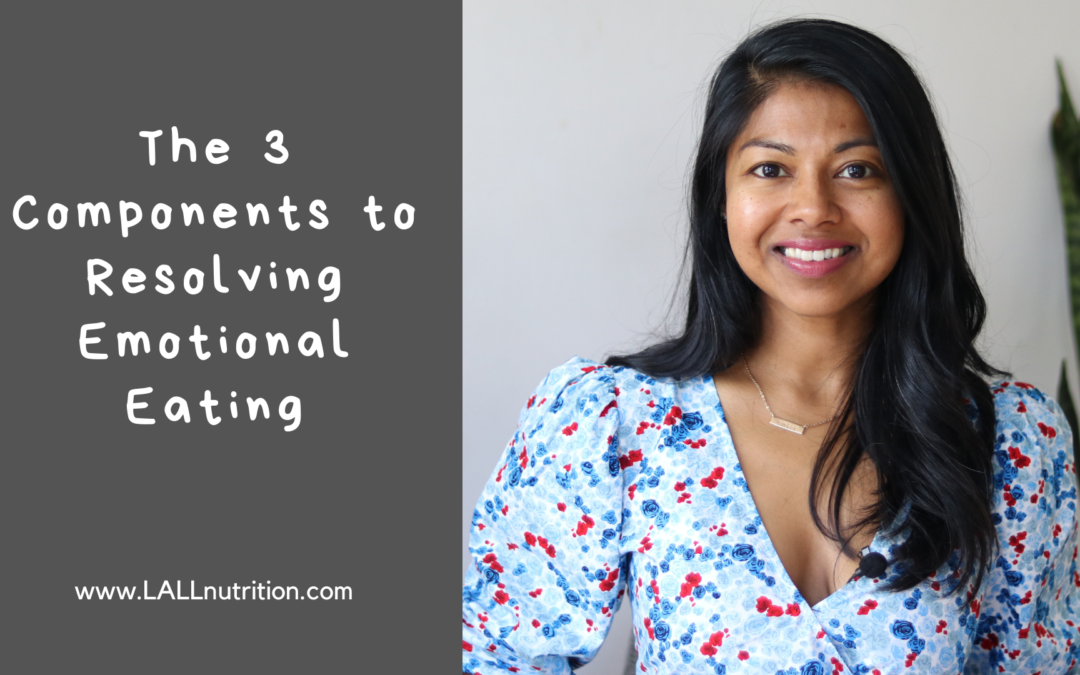Hello love,
Today I wanted to share about how emotions are not just something that we need to “deal with” necessarily, in emotional eating. We need to look at emotional eating from different perspectives. In the past you would think with emotional eating that you had to just work on your emotions and there was no talk about the body and what was really going on, even though they are so connected.
I know that’s how it was for me, it was all disconnected. I was trying to figure out my emotional eating, figure out my healthy eating and my self talk. I didn’t know how they were all connected. I was separating it all. There wasn’t this continuous method I could look at and really understand what was happening.
Over time, I had to connect everything in a holistic way. When I started putting the pieces together and made such a huge difference, and that’s what I teach clients so that they get a grasp on their emotional eating. Emotional eating is using food to emotionally cope.
The Components make a difference altogether…
But it’s not just about our emotions. It’s about what we put in our body. It’s what we say to ourselves. So you really need to create a foundation for yourself. You need to get all these different pieces connected in a holistic way to really start getting results. To start getting a handle on your emotional eating.
This was happening for me when I was experimenting and going through all of this. I was putting all of these pieces together. But when I really stood back and saw that I needed each piece to really get a handle on my emotional eating. It wasn’t just one little thing that got me there. It was all of these things together.
Component 1
The first component starts off with true nourishment. True nourishment is how you’re feeding your body and digesting your food.
This component is strategic. It’s strategic about your digestion and how you’re feeding your body. A lot of times clients think that they’re really eating well because there’s so much nutritional noise out there. It’s hard to see; Is this really working for me? Is this right? How do I know this is going to help my body?
And if they are eating in a certain way, they don’t know how it connects to their mood. And that’s where digestion really comes in. Our digestion is so linked to our mood. So it’s one factor in our emotional eating. Of course, if our moods are not great, we’re going to turn to food. especially if we are emotional eaters and use food to feel better. So we really need to look at digestion and we also need to be truly nourishing our body so that we know that we’re managing our moods and our stress.
Component 2
The second key area that was really pivotal for me and clients is body acceptance. It’s body acceptance and the way we talk to ourselves about our body. This component includes our beliefs around our body, and understanding our basic physiology. This helps us see that diets train us to be against our body.
Body acceptance helps us flip the script we’ve been sold for so long, It helps us tune into our bodies; how amazing our body is, what our body needs, that our energy changes throughout the month, that what we need to eat more or less, etc.
There’s nothing wrong with us, even though we’ve been sold this dieting philosophy that says we have to eat a certain amount of calories and eat in this certain way. When we come back to body acceptance, we really start tuning into our body and accepting our body for where it’s at. And that’s the starting point to creating true transformation and true change, because we know what our body needs and that if it’s off for a few days, we know why.
Component 3
This is a key component in emotional eating and emotional wellness in general. If we’re using food to cope with our emotions, that means we don’t know how to be with our emotions. It’s not your fault because in our society, we’re not taught how to be with our emotions. Most likely our parents would have not known how to be with their emotions as well and could not teach or model for us.
Today, there are more emotionally aware and intelligent people, but in general, we still have a long way to go. If you learned to use food to feel better about your emotions or were taught that, you’ll use food. IF you’re here reading this, you know that something needs to shift because that doesn’t work anymore. The more you use food to cope with your emotions, you create more pain in your body.
You’re going to feel more guilty. You’re going to feel more out of control. You’re going to just feel more ashamed and have shame. I totally know how that feels because every time I would binge, I would feel so out of control. Every time I went out for dinner and just eat and eat and eat and felt like I was full till my eyeballs. I felt stuffed. I felt out of control. I felt really disgusted with myself.That’s what happens when we’re we don’t know how to move through our emotions.
Emotional wellness is a key factor to move through your emotions. It can be as simple as journaling to to going deeper into the body level of the emotion. This processes the emotion at a deeper level and to integrate it.
An Example
I want to tell you about this client that started working with me. When she came to me she had been doing so much inner work. She knew she needed help with getting healthy because her health was not the best. She didn’t think she was an emotional eater.
As we moved through the program, she started seeing how she gets triggered. That it’s very emotional and she does go to food to feel good. But if you just asked her, are you an emotional eater, she wouldn’t have connected the two. It’s taken some time to connect it. And that’s a really amazing thing with my program, is that you can start connecting these triggers and start seeing what’s happening and working with them.
You gain so much more awareness and you really start tuning into what you need and how to process through it. In this particular situation that’s triggering her, would you think she developed it in that moment? No. This pattern goes back to childhood. And through our work, we’ve we’ve gone back and we’ve seen where it started. And when you really start seeing where it started, you can make different choices. You can move through your life differently. You can meet your needs.
So eating to cope with emotions, even though that’s what you’ve been doing, you’re at a point where it doesn’t feel good. And now you need a better way. Hopefully you’re here and you’re listening – there is a better way. There is a way to actually meet your needs. Your emotions are trying to talk to you about what you actually need.
So to summarize the 3 key areas that you need to look at to move through emotional eating is to look at how you nourish yourself. Are you digesting well? Are you feeding your body to help your moods?
The second key is body acceptance. What are you saying to yourself? What are your beliefs around your body? Do you understand your body and what’s been sold to you in the general dieting world?
And finally, the emotional wellness aspect. Did you learn how to really process your emotions? Can you move through your emotions and not use food to distract you?
These 3 key areas are super powerful and pivotal to connect all that’s needed to get a handle on emotional eating. Sometimes (almost always) we need to start with a little baby step. There’s a resource linked below “What are you truly hungry for?” This guide is going to help you distinguish between true and emotional hunger and give you a few tips about triggers and how to start working with them. You can download the guide below.
And if you have any questions or comments, please let me know. I look forward to sharing more with you and I hope you have a great day.
To resolution,
~Michelle
Certified Holistic Nutritionist.


